CBS data: from the end of the seventies of the last century to the mid-9,253s, the number of students in the humanities was on the rise from 1976 in 7/22,882 to a peak of 2004 in 05/17,931. After that, the trend changed and since then the number of students has been on a downward trend and reached 2016 in 17 (XNUMX/XNUMX). The decreasing number of students in the humanities in the last decade is particularly noticeable in light of the increase in the number of all students.

The main points of the CBS data:
- The percentage of students in the humanities has dropped significantly in the last thirty years, from 23.3% of students in 1983/84 to 7.7% in 2016/17.
- In the last decade, the number of students in the humanities also decreased in absolute numbers, from 22,882 in 2004/05 to 17,931 in 2016/17.
- In the years 2016-17 (1996/97-74/60) the number of students decreased in most subjects, especially in subjects with a local-Israeli emphasis: Hebrew literature (by 56%), Hebrew language (61%) and Israeli history ( 127.5%). In contrast, the number of students in subjects such as East Asian Studies (XNUMX%) and Cultural Studies (XNUMX%) increased.
- Bachelor's degree studies in the humanities have become less focused and more interdisciplinary. At the end of the 2016s, one out of ten humanities students studied general studies in the humanities, compared to one out of three students in 17 (XNUMX/XNUMX).
- The range of subjects that can be studied in the humanities at universities and academic colleges decreased from 52 in 2000 (01/41) to XNUMX in XNUMX.
- From the 30s onwards, XNUMX subjects (and courses) are no longer taught at the various universities.
- Similar to the trend of the decrease in the number of students, the percentage of applicants for humanities subjects out of all applicants in universities has decreased significantly in the last thirty years, from 16.9% in 1984/85 to 7.9% in 2016/17.
- Despite the decrease in demand for humanities studies in universities, the level of students' previous achievements did not decrease and even increased. The average matriculation score among humanities students in universities increased gradually, from 8 in 2002 (03/94.7) to 5 in 61.2. The percentage of humanities students in universities who were tested in 67.9 units in English was on the rise - from XNUMX% in XNUMX to XNUMX% in XNUMX.
- The percentage of humanities students who were examined in the advanced matriculation in the humanities (history, philosophy and literature) dropped significantly, from 37.2% in 30.7 to XNUMX% in XNUMX.
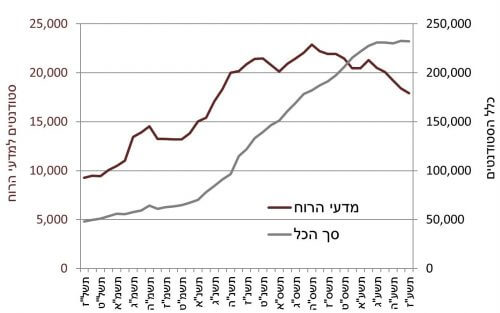
The share of humanities students is on a downward trend from the mid-2s to the present day (Chart 23.3). The percentage of humanities students dropped from 1983% of all students in 84/7.7 to 90% in 2.2. The decrease in the percentage of students studying the humanities is due to the addition of the academic colleges in the 13.9s, where the study of the humanities is relatively marginal (23.3% in 1984). Also, it stems from a decrease in the proportion of people studying the humanities in universities, in 85 it reached a minimum of XNUMX% (from XNUMX% in XNUMX/XNUMX).
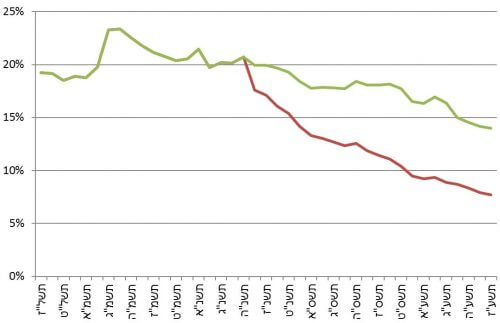
percentages of all students. Source: CBS.
trends in humanities studies
In the last twenty years (74-60), the number of students in most subjects in the humanities has decreased, although at a different rate. In subjects with a local-Israeli emphasis, the sharpest decrease occurred: Hebrew literature (XNUMX% decrease), Hebrew language (XNUMX%) and Israeli history[1] (56%). Conversely, the rate of decline was smaller in the more applied subjects: archeology (31%) and Israel studies (37%). In contrast to the decrease in the number of students in most subjects in the years 90-61, there were subjects in which there was a significant increase: cultural studies (37.5%), East Asian studies (XNUMX%), and general studies (XNUMX%). In Jewish studies, the number of students remained relatively stable.
Table A - The number of humanities students in higher education institutions in selected subjects[2], 1996 (97/2016) and 17 (XNUMX/XNUMX)
| XNUMX . | XNUMX . | |
| Hebrew literature | 2,359 | 621 |
| Israeli history | 2,273 | 1,002 |
| General history | 2,486 | 1,275 |
| Languages[3] | 2,204 | 1,074 |
| Hebrew language | 1,285 | 511 |
| History of Islam and its countries[4] | 2,278 | 1,639 |
| English | 1,755 | 1,241 |
| AI studies | 1,361 | 856 |
| philosophy | 1,620 | 1,166 |
| General literature | 811 | 409 |
| Archeology | 820 | 565 |
| Jewish Studies[5] | 2,310 | 2,296 |
| East Asian Studies | 580 | 934 |
| cultural studies[6] | 543 | 1,033 |
| General humanities | 3,244 | 4,462 |
| other | 658 | 477 |
General studies for a bachelor's degree in the humanities
Bachelor's degree studies in the humanities have become less focused and more interdisciplinary. In the last decade, the percentage of people studying general studies in the humanities has steadily increased. In XNUMX, one out of three humanities students studied general studies. In contrast, thirty years earlier, in the late XNUMXs, only one out of ten students studied general studies in the humanities.
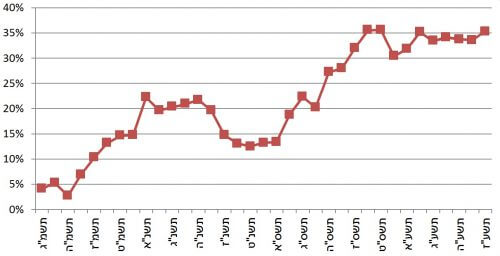
Study subjects in the humanities
The number of subjects that can be studied in the humanities at universities and academic colleges decreased by 20% in the 52s, from 2000 in 01 (41/20) to 204 in 2000. In contrast, the number of all subjects studied in universities and academic colleges increased by 01% - from 245 in 2016 (17/XNUMX) to XNUMX in XNUMX/XNUMX.
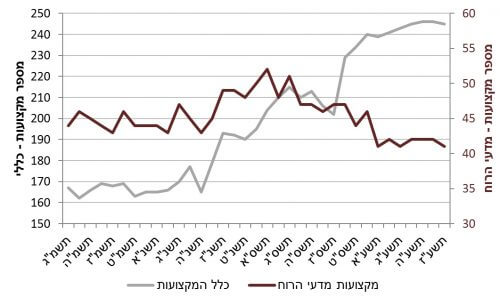
Reducing the number of humanities subjects in universities
Over the past forty years, the number of humanities departments in universities has decreased, some have merged and some have disappeared. That is, some of the study subjects are no longer studied as a study group, but are studied as majors or as part of other study subjects. In some universities it is not possible to study subjects such as Indian, Iranian and Armenian studies, African history, Semitic linguistics and the history of Russia and Eastern Europe. In all universities it is not possible to study in 6 for a bachelor's degree in Assyrology, Egyptian or German. On the other hand, over the years general subjects such as European studies and cultural sciences have been added in the universities. In diagram XNUMX it can be seen that the closing of the classes occurred mainly from the beginning of the XNUMXs.
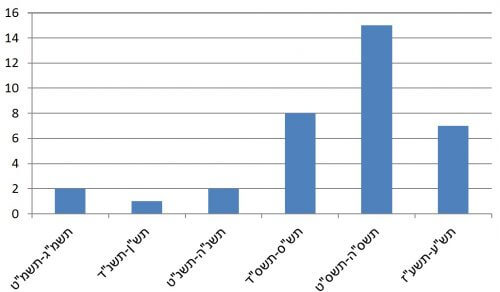
Candidates for undergraduate studies in the humanities
Similar to the trend of the decrease in the percentage of students, the percentage of applicants for humanities subjects out of all the applicants in universities has decreased significantly in the last thirty years, from 16.9% in 1984/85 to 7.9% in 2016/17.
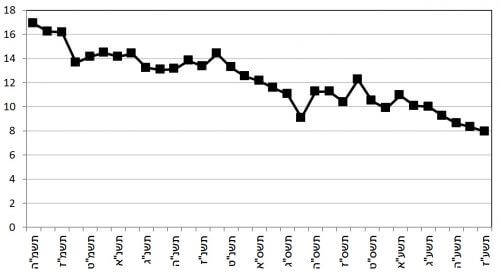
Characteristics of humanities learners
The percentage of women studying the humanities is similar to their share in other fields of study. But the age distribution is very different than in the other fields of study - the proportion of people over sixty among those studying for a PhD in the humanities is 10% compared to an average of 1.3% in the other fields. Similarly, the percentage of people aged fifty-five and over studying for a master's degree is 11.2% compared to 1.7%, and in the bachelor's degree the percentage of people aged forty and over is double (11% compared to 5.1%, respectively). The proportion of Arabs studying for a bachelor's degree in the humanities is higher than their proportion in the other fields of study (19.9% versus 13.4%, respectively), but significantly lower in the master's degree (13.6% versus 8.8%, respectively).
Matriculation among university humanities students
Despite the decrease in demand for humanities studies in universities, the level of achievement of the students did not decrease and even increased. This is in contrast to economics studies where the decrease in demand for the subject was accompanied by a decrease in student achievement (see press release Bachelor's degree studies in economics, 2016/17).
The average matriculation score among humanities students in universities has gradually increased, from 90.8 in 2002/03 to 94.7 in 2016/17. However, this score is still lower than the average score of the other university students. The gap between the average score of humanities students and the average score of the rest of the students was reduced by 1.8 points, from 5.5 in 3.7 to XNUMX in XNUMX.
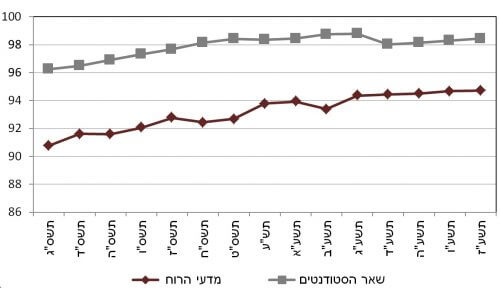
The percentage of humanities students in universities who were tested in 5 units in the matriculation exam in English is on the rise - from 61.2% in 2002/03 to 67.9% in 2016/17. In contrast, the percentage of other university students did not drop below 72% over the years.
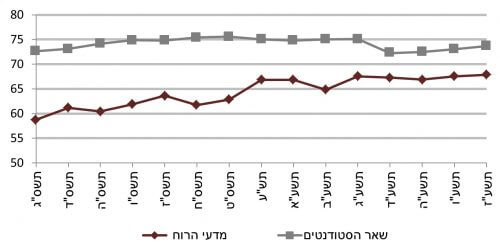
The percentage of humanities students in universities who were tested in 5 units in mathematics was much lower than the percentage among other university students. In the year 2016/17, the percentage of humanities students who were tested in 5 units in the matriculation in mathematics was only 19% compared to 43% among the other students in the universities.
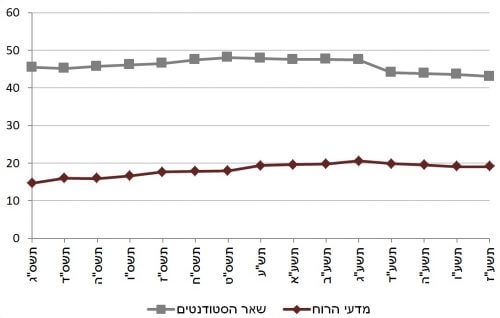
The tests in the humanities in the matriculation exams
The percentage of humanities students who were tested in the advanced matriculation exam in the humanities subjects - history, philosophy and literature, decreased significantly over the years, from 37.2% in 2002/03 to 30.7% in XNUMX, but it was still relatively high Significantly more than among the other students.
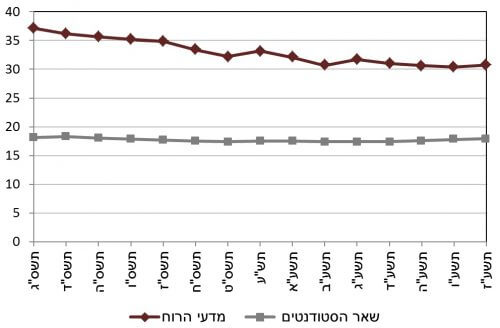
Improving skills among humanities students
as part of a survey[7] Conducted by the CBS, interesting findings were found regarding the differences in skill improvement during the studies as reported by the students. Humanities students reported that they improved their general knowledge, written and oral expression, and English proficiency more than students from other fields of study. Conversely, fewer students in the humanities reported that they had improved their quantitative skill and technological ability than students from other fields of knowledge.
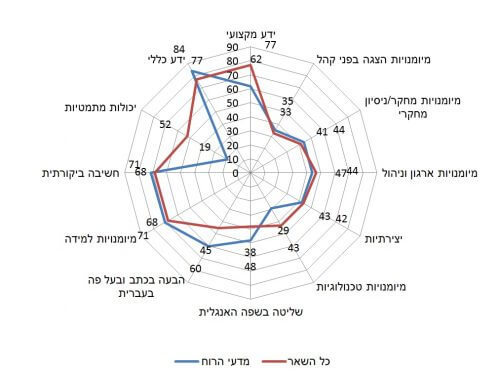
Definitions and explanations
The data presented in the notice are based on administrative files received from the institutions of higher education, and include personal data of students. These files go through processes of data processing, unification and refinement at the Central Bureau of Statistics. Additional data was obtained by linking additional data files to the files held by the Central Bureau of Statistics.
The population of the announcement - includes humanities students at universities and academic colleges and does not include humanities students at the Open University.[8]
Humanities - include the historical sciences, Jewish studies, philosophy, archaeology, languages, literature and culture. Educational sciences and the arts of their kind are not included.
Humanities students - those who studied in a first subject or a secondary subject in one of the humanities subjects.
Disappearance of a profession in the institution - A subject that new students have not started studying at a certain institution.
Educational institutions where humanities are studied
Universities: The Hebrew University of Jerusalem; Tel Aviv University; Bar-Ilan University; Ben Gurion University in the Negev; Haifa University; Ariel University in Samaria.[9]
Academic colleges: Tel Hai Academic College; Sapir Academic College; Ashkelon Academic College; Kinneret Academic College in the Jordan Valley; Safed Academic College; Afraternity Academic College; Western Galilee Academic College; Ono Academic College; Schechter Institute for Jewish Studies; The academic center is complete.
Comments
[1] History of the people of Israel.
[2] For the purpose of preparing this table, several professions close to one profession were grouped.
[3] Languages including: German language and literature, Italian language and literature, Arabic language and literature, Yiddish language and literature, French language and literature, translation and language and its uses.
[4] Including the subject of the history of Islam and its culture.
[5] Jewish Studies includes the subjects: Bible (Bible), Talmud (XNUMXth century Torah), Judaism, history of Jewish thought, Jewish philosophy.
[6] Cultural studies includes the subjects: classical studies, Spanish and Latin American studies, Russian and Slavic studies, Indian, Iranian and Armenian studies, cultural studies, cultural sciences.
[7] For extensive information on the acquired skills, see the press release Skills and knowledge that students improve in the first two years of undergraduate studies findings from the 2014 Higher Education Survey
[8] The Open University has characteristics that set it apart from other higher education institutions. This is reflected in the students' admission processes and during their studies, in the composition of the student population, and more. Therefore, the data in this announcement do not include the data of the Open University. However, the ambition is to integrate the data of the Open University into the current statistics of the higher education institutions, while taking into account its uniqueness.
[9] As of 2013/14, a new university was added - Ariel University in Samaria. From this year, the students at this institution are included in the university data. Until the year 2012 (13/XNUMX, including this year) these students were included in the data of the budgeted academic colleges.

One response
A fascinating article that explains the decline of academia in Israel can be read at the link
http://www.gplanet.co.il/prodetailsamewin.asp?pro_id=2732